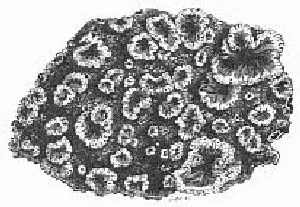This, when examined with a lens, is
8

found to consist of numerous exceedingly thin layers, its total thickness being about the tenth of an inch. It contains much animal matter, and its origin, no doubt, is due to the action of the rain or spray on the birds' dung. Below some small masses of guano at Ascension, and on the Abrolhos Islets, I found certain stalactitic branching bodies, formed apparently in the same manner as the thin white coating on these rocks. The branching bodies so closely resembled in general appearance certain nulliporæ (a family of hard calcareous sea-plants), that in lately looking hastily over my collection I did not perceive the difference. The globular extremities of the branches are of a pearly texture, like the enamel of teeth, but so hard as just to scratch plate-glass. I may here mention, that on a part of the coast of Ascension, where there is a vast accumulation of shelly sand, an incrustation is deposited on the tidal rocks, by the water of the sea, resembling, as represented in the picture above, certain cryptogamic plants (Marchantiæ) often seen on damp walls. The surface of the fronds is beautifully glossy; and those parts formed where fully exposed to the light, are of a jet black colour, but those shaded under ledges are only grey. I have shown specimens of this incrustation to several geologists, and they all thought that they were of volcanic or igneous origin! In its hardness and translucency--in its polish, equal to that of the finest oliva-shell--in the bad smell given out, and loss of colour under the blowpipe--it shows a close similarity with living sea-shells. Moreover in sea-shells, it is known that the parts habitually covered and shaded by the mantle of the animal, are of a paler colour than those fully exposed to the light, just as is the case with this incrustation. When we remember that lime, either as a phosphate or carbonate, enters into the composition of the hard parts, such as bones and shells, of all living animals, it is an interesting physiological
9
fact1 to find substances harder than the enamel of teeth, and coloured surfaces as well polished as those of a fresh shell, re-formed through inorganic means from dead organic matter--mocking, also, in shape, some of the lower vegetable productions.
1. Mr. Horner and Sir David Brewster have described (Philosophical Transactions, 1836, p. 65) a singular "artificial substance resembling shell." It is deposited in fine, transparent, highly polished, brown-coloured laminae, possessing peculiar optical properties, on the inside of a vessel, in which cloth, first prepared with glue and then with lime, is made to revolve rapidly in water. It is much softer, more transparent, and contains more animal matter, than the natural incrustation at Ascension; but we here again see the strong tendency which carbonate of lime and animal matter evince to form a solid substance allied to shell.
We found on St. Paul's only two kinds of birds--the booby and the noddy. The former is a species of gannet, and the latter a tern. Both are of a tame and stupid disposition, and are so unaccustomed to visitors, that I could have killed any number of them with my geological hammer. The booby lays her eggs on the bare rock; but the tern makes a very simple nest with seaweed. By the side of many of these nests a small flying-fish was placed; which I suppose, had been brought by the male bird for its partner. It was amusing to watch how quickly a large and active crab (Graspus), which inhabits the crevices of the rock, stole the fish from the side of the nest, as soon as we had disturbed the parent birds. Sir W. Symonds, one of the few persons who have landed here, informs me that he saw the crabs dragging even the young birds out of their nests, and devouring them. Not a single plant, not even a lichen, grows on this islet; yet it is inhabited by several insects and spiders. The following list completes, I believe, the terrestrial fauna: a fly (Olfersia) living on the booby, and a tick which must have come here as a parasite on the birds; a small brown moth, belonging to a genus that feeds on feathers; a beetle (Quedius) and a woodlouse from beneath the dung; and lastly, numerous spiders, which I suppose prey on these small attendants and scavengers of the waterfowl. The often-repeated description of the stately palm and other noble tropical plants, then birds, and lastly man, taking possession of the coral islets as soon as formed, in the Pacific, is probably not quite correct; I fear it destroys the poetry of this story, that feather and dirt-feeding and parasitic insects and spiders should be the first inhabitants of newly formed oceanic land.
The smallest rock in the tropical seas, by giving a foundation
10
for the growth of innumerable kinds of seaweed and compound animals, supports likewise a large number of fish. The sharks and the seamen in the boats maintained a constant struggle which should secure the greater share of the prey caught by the fishing-lines. I have heard that a rock near the Bermudas, lying many miles out at sea, and at a considerable depth, was first discovered by the circumstance of fish having been observed in the neighbourhood.
FERNANDO NORONHA, Feb. 20th.— As far as I was enabled to observe, during the few hours we stayed at this place, the constitution of the island is volcanic, but probably not of a recent date. The most remarkable feature is a conical hill, about one thousand feet high, the upper part of which is exceedingly steep, and on one side overhangs its base. The rock is phonolite, and is divided into irregular columns.
1 comment